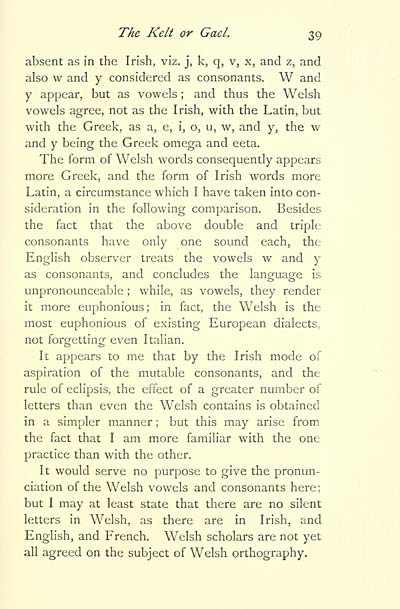Blair Collection > Kelt or Gael
(43)
Download files
Complete book:
Individual page:
Thumbnail gallery: Grid view | List view

The Kelt or Gael. 39
absent as in the Irish, viz. j, k, q, v, x, and z, and
also w and y considered as consonants. W and
y appear, but as vowels ; and thus the Welsh
vowels agree, not as the Irish, with the Latin, but
with the Greek, as a, e, i, o, u, w, and y, the w
and y being the Greek omega and eeta.
The form of Welsh words consequently appears
more Greek, and the form of Irish words more
Latin, a circumstance which I have taken into con-
sideration in the following comparison. Besides
the fact that the above double and triple
consonants have only one sound each, the
English observer treats the vowels w and y
as consonants, and concludes the language is
unpronounceable ; while, as vowels, they render
it more euphonious; in fact, the Welsh is the
most euphonious of existing European dialects,
not forgetting even Italian.
It appears to me that by the Irish mode of
aspiration of the mutable consonants, and the
rule of eclipsis, the effect of a greater number of
letters than even the Welsh contains is obtained
in a simpler manner ; but this may arise from
the fact that I am more familiar with the one
practice than with the other.
It would serve no purpose to give the pronun-
ciation of the Welsh vowels and consonants here;
but I may at least state that there are no silent
letters in Welsh, as there are in Irish, and
English, and French. Welsh scholars are not yet
all agreed on the subject of Welsh orthography.
absent as in the Irish, viz. j, k, q, v, x, and z, and
also w and y considered as consonants. W and
y appear, but as vowels ; and thus the Welsh
vowels agree, not as the Irish, with the Latin, but
with the Greek, as a, e, i, o, u, w, and y, the w
and y being the Greek omega and eeta.
The form of Welsh words consequently appears
more Greek, and the form of Irish words more
Latin, a circumstance which I have taken into con-
sideration in the following comparison. Besides
the fact that the above double and triple
consonants have only one sound each, the
English observer treats the vowels w and y
as consonants, and concludes the language is
unpronounceable ; while, as vowels, they render
it more euphonious; in fact, the Welsh is the
most euphonious of existing European dialects,
not forgetting even Italian.
It appears to me that by the Irish mode of
aspiration of the mutable consonants, and the
rule of eclipsis, the effect of a greater number of
letters than even the Welsh contains is obtained
in a simpler manner ; but this may arise from
the fact that I am more familiar with the one
practice than with the other.
It would serve no purpose to give the pronun-
ciation of the Welsh vowels and consonants here;
but I may at least state that there are no silent
letters in Welsh, as there are in Irish, and
English, and French. Welsh scholars are not yet
all agreed on the subject of Welsh orthography.
Set display mode to: Large image | Transcription
Images and transcriptions on this page, including medium image downloads, may be used under the Creative Commons Attribution 4.0 International Licence unless otherwise stated. ![]()
| Early Gaelic Book Collections > Blair Collection > Kelt or Gael > (43) |
|---|
| Permanent URL | https://digital.nls.uk/75787157 |
|---|
| Description | His ethnography, geography and philology. |
|---|---|
| Shelfmark | Blair.17 |
| Additional NLS resources: | |
| Attribution and copyright: |
|
| Description | A selection of books from a collection of more than 500 titles, mostly on religious and literary topics. Also includes some material dealing with other Celtic languages and societies. Collection created towards the end of the 19th century by Lady Evelyn Stewart Murray. |
|---|
| Description | Selected items from five 'Special and Named Printed Collections'. Includes books in Gaelic and other Celtic languages, works about the Gaels, their languages, literature, culture and history. |
|---|

